
Grinding a few new gears with “RoboCop 2” and heading to the chapel with “Betsy’s Wedding.”

RoboCop 2
Nutshell: In the throes of crippling debt, the city of Detroit is about to be privatized by the villainous corporation OCP. Watching as their salaries plummet, the local cops have taken to the picket line for proper wages, leaving Robocop/Alex Murphy (Peter Weller) alone to fight a growing epidemic concerning a vicious narcotic nicknamed “Nuke.” The leader of the Nuke revolution is a madman named Cain (Tom Noonan), who OCP targets for their new cyborg initiative “RoboCop 2,” hoping to manufacture a new generation of police protection without all the silly emotional devastation that’s plagued Murphy’s mind while trapped inside his body of steel.
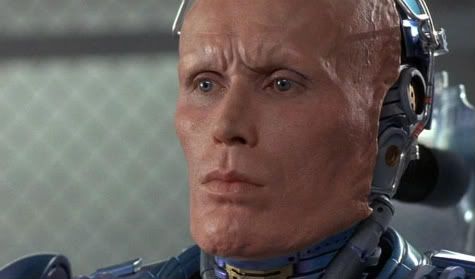
1990: I can’t recall what movie was screened that fateful afternoon in 1987, but I vividly remember the theatrical trailer for “RoboCop” — a flash of amber images teeming with explosions, robots, and gun-totin’ heroism. Of course, any kid would be raring to devour the final product, so imagine my utter disappointment to learn that this shiny, roughhouse wonderland of a futuristic cop movie was rated R, meaning possible years before I could catch up to it. Foiled once again by Jack Valenti.
Turns out it wasn’t all that long before I wrapped my paws around a copy of “RoboCop.” The film came into my life quicker than I was expecting, only to find out exactly why I was prohibited by the MPAA to see it. Paul Verhoeven’s original film was a sick, sly masterpiece of splashing guts and social commentary, eager to splatter brains across the screen while keeping satirically mindful of current events, even building something of a religious allegory to help the violence reach its full potential. It stunned from the very first frame, locking me into my seat as this forbidden fruit was paraded in front of my impressionable eyes; the film showed me cinematic sights I’d never seen before. What seemed like a slam-dunk kids film on the outside was anything but on the inside. I was scarred. Tipped over. Changed.
I loved it.

Because Orion Pictures wasn’t exactly a hit factory in 1989, the suits ordered up another adventure for Alex Murphy, but this time Verhoeven wasn’t around to take charge of the film’s steamrolling tone. Enter Irvin Kershner, best known for his monumental directorial achievement on the 1970 film, “Loving.” No! The man also directed “The Empire Strikes Back.” You know, the best of the “Star Wars” films, and the one George Lucas exerted the least amount of creative control over? Sensing his sparkling track record with first sequels, Orion handed the film over to Kershner with the edict to match Verhoeven’s style, a feat assisted by a screenplay from Frank Miller, wet with graphic novel overtones.
As we all know now, there’s only one Paul Verhoeven. “RoboCop 2” was immensely amusing at the time, but it was apparent the original film’s crafty touch was missing, buried under a script trying too hard to keep the “RoboCop” universe colorful and brutal, with a tremendous acceleration in sadism to give the sequel an edge. “RoboCop 2” was an unnerving moviegoing experience due to the ultraviolence, appearing more mean-spirited and unsophisticated, killing the cyborg vs. cyborg joyride the film was intended to be. While I approved of the picture in 1990 (what kid wouldn’t?), I did make a blunt note in the Brichives that the sequel “wasn’t as good as the original.” Considering how much of a pushover I was at the time, there’s a palpable amount of disappointment in those words, despite my overall approval of the crunchy RoboCopian antics dreamed up for this fresh round of crime fighting.
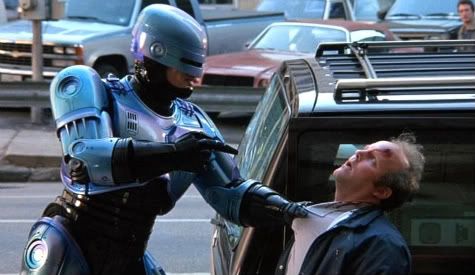
2010: The script for “RoboCop 2” feels like a patchwork quilt of ideas, with the film divided up into four sections for easier digestion. The first quarter is devoted to the ongoing sickness of Murphy, who’s unable to shake the memories of his once thriving domestic life before sewn into his RoboCop prison. Considering it’s the first act within a sequel, Kershner and Weller nail a few awesomely poignant moments of utter despair, as Murphy is goaded into accepting his new metal skin by lawyers, despite his heart and mind telling him different. It’s all quite emotional and brittle, which is probably why this tragic material is shoved into the opening 30 minutes of the movie, clearing away the pesky character development to play Rock ‘Em Sock ‘Em Robots later on.

In 1990, I wasn’t aware who Frank Miller was. Now, I know him all too well, making the sequel’s ink and paint ambiance easier to read…and easier to dismiss. The central Nuke idea is a promising one, creating a citywide desperation that leads RoboCop back into duty. However, the screenplay also seeks to cover OCP’s internal machinations, introducing the character of Dr. Faxx (Belinda Bauer), a callous woman (does Miller know any other kind?) driven to impress her bosses by perfecting RoboCop 2, leading her to Cain as the perfect brain candidate. With drugs, gangs, boardroom antics, and a few too many villains (including Hob, a salty 12-year-old bully played by an overly gelled Gabriel Damon), there’s little time for our old pal Robo, splintering the film into various directions, unified only through gratuitous violence.
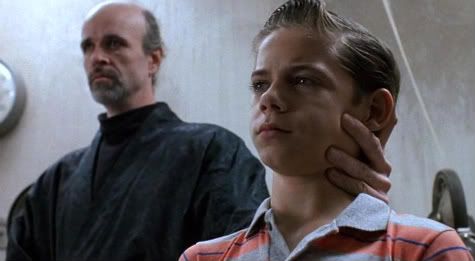
“RoboCop 2” remains a vicious film, but now it’s a little easier to spot why the picture was so adamant to bring the pain. Kershner seems confused by the gig, dropping Verhoeven’s satiric tone to create a more rudimentary adventure, despite the return of the faux commercial breaks selling horrible products for a horrible future. While entertaining, the sequel just isn’t sneaky enough, barreling forward where Verhoeven peacocked impressively. The gruff nature of the feature results in a handful of accomplished sequences (I still enjoy the arcade showdown with Hob and the blasting Babylon A.D.), but the majority of the picture seems unnecessarily angry, assuming the very act of screen slaughter is enough to match the first film.
What the follow-up has in its favor are its special effects, which summon a wonderful low-fi mood of stop-motion animation and rear projection efforts, sustaining the action’s texture and appeal. The make-up and puppetry are also mind-blowing, lasting through some intense close-ups where human characters interact plausibly with animatronic creations. Paltry dramatics aside, the entire film is one long set-up for the demolition derby climax, where RoboCop and junkie cyborg RoboCop 2 go mano-a-mano on the streets of Detroit. Kershner gives the wargasm 12 long minutes of screentime to play out, giving fans a jolt of battling bots to bring the film to a rewarding conclusion. Whatever faults are present in the sequel, the picture manages to unleash triumphantly in the last act, blasting and beating away as metal scrapes metal. It’s pretty darn cool, even now in this age of slickity-slick VFX.

I’ll maintain that “RoboCop 2” is a worthy sequel, though with every fresh viewing I see more of its faults and scatterbrained structure. However, compared to the travesty of “RoboCop 3,” which decided to take on the franchise armed with a PG-13 rating and without the services of Peter Weller, the first sequel is practically another “Empire Strikes Back.”
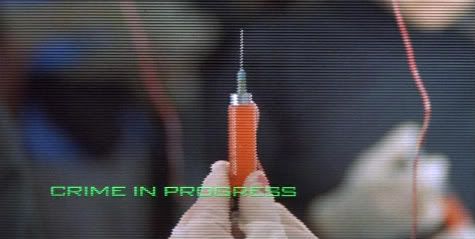

Betsy’s Wedding
Nutshell: Construction developer Eddie Hopper (Alan Alda) is facing troubling financial times, only to be greeted with the news that his youngest, Betsy (Molly Ringwald), is now engaged to the son of a wealthy investment banker. Escalating once modest wedding plans to make up for his feelings of inadequacy, Eddie turns to brother-in-law Oscar (Joe Pesci) for a loan to cover the costs. Instead of a simple monetary transaction, Oscar turns Eddie’s latest project over to the mob, freaking the father of the bride out, resulting in further wedding day hysteria and the appearance of Stevie Dee (Anthony LaPaglia), an inexperienced goombah who’s fallen in love with Eddie’s other daughter, policewoman Connie (Ally Sheedy).

1990: “Betsy’s Wedding” isn’t actually a member of the Summer of 1990 for me, as I passed on the film to devour other, more concentrated genre affairs due to my age and the excitement of the season. I caught up with the feature on video, curious to see Ringwald embrace a slightly less pronounced role during the depreciation period of her career. As a fan during her Hughes heyday, it was bizarre to watch the actress attempt to break out of her niche, especially with films such as “The Pick Up Artist” and “Fresh Horses” (and to a lesser extent, the pregnancy drama “For Keeps”), which allowed Ringwald to spread her wings as an actress, only to find there just wasn’t much there to build upon. A strawberry icon, Ringwald never really became the powerhouse star she was positioned to be, but that didn’t mean I would dare to give up on her, hoping to be around when she finally connected to a role that would launch her back into Hollywood royalty.
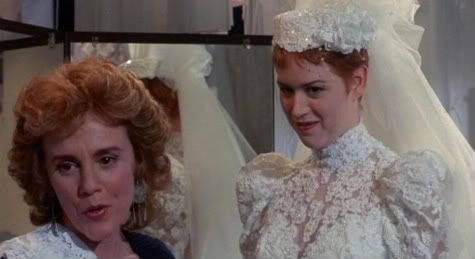
“Betsy’s Wedding” didn’t do the trick in 1990, but it was an interesting career move for Ringwald, looking to get lost inside an ensemble piece under the tutelage of ace actor Alan Alda, here sealing shut his erratic directing career with a mild matrimonial comedy that didn’t spark up the box office, despite its primo positioning as summer season counterprogramming.

2010: “Betsy’s Wedding” is a comedy in search of laughs, despite Alda’s insistence that everything here is hilarious. The feature is truly Alda’s baby, directing, writing, and starring in the film, which is something he has difficulty corralling from time to time, overwhelmed with the size of the cast and the focal point of the story.
That’s not to suggest the film is unpleasant. Working a bizarre Woody Allen via Martin Scorsese tone, Alda is clearly having a ball working the characters into situations of conflict and reflection, avoiding most drips of saccharine along the way to play the material as a farce, only absent the appropriate freewheeling attitude. The feature has a few scattered laughs and a superb supporting cast, which includes Catherine O’Hara, Madeline Kahn, Burt Young, and an embryonic Dylan Walsh, here roughly five years before his big coming out party in the frightful adventure film “Congo.” The cast is ready to play, creating a nice simmer of chemistry, and everyone seems comfortable in the New York/North Carolina locations. Trouble is, Alda doesn’t offer them much to do.

There’s an unfinished vibe to picture that keeps matters disjointed, most pointedly in the character of Eddie, who seems to be marked as the lead character, with Alda embellishing the character’s dream life to portend great anxiety or false reassurance, personified by the appearance of his deceased father, played with gaiety by Joey Bishop. The trips to the subconscious are random, but funny (a bit with Eddie fending off a tiger is a riot), though they suggest the screenplay was going to spotlight Eddie’s psychological path to the wedding day. Instead, the character is quickly shoved to the background to make room for some class warfare and a mafia subplot that gives Pesci room to squeak. The loss of direction kills the momentum of the feature, while diluting the dreamscape snapshots into Eddie’s mind, makes the asides more baffling than side-splitting.

“Betsy’s Wedding” runs through a routine of wedding jitter material, though it doesn’t seek out the corrosive verbal fire of Nancy Savoca’s “True Love” or the warm spirit of Charles Shyer’s “Father of the Bride” remake. Instead, the film doesn’t summon much of a reaction at all, leaving the eventual parade of sentimentality D.O.A. I was entertained by “Betsy’s Wedding,” but never enlivened by it, despite appreciating the emotional colors and slapstick lunges more now than I did decades ago. It appears Alda had some great ideas before he gave up directing, but rarely did he ever connect in full.

Reliving the movies of 1990 – Part 1 (Firebirds, Back to the Future 3)
Reliving the movies of 1990 – Part 2 (Total Recall)
Reliving the movies of 1990 – Part 3 (Another 48 Hours)
Reliving the movies of 1990 – Part 4 (Dick Tracy, Gremlins 2)

